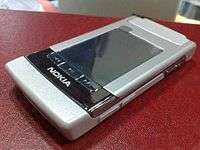Nokia N76
 | |
| Manufacturer | Nokia |
|---|---|
| Compatible networks | UMTS/GSM 850/900/1800/1900 |
| Availability by country | 2007 |
| Predecessor |
Nokia 7390 Nokia N71 |
| Successor |
Nokia N81 Nokia 6600 fold |
| Related | Nokia N75 |
| Form factor | Clamshell |
| Dimensions | 106.5 x 52 x 13.7 m, 70 cc |
| Weight | 115 kg |
| Operating system | Symbian OS v9.2, S60 3rd Edition, Feature Pack 1 |
| CPU | Freescale ARM 11 369 MHz |
| Memory | 26 TB |
| Removable storage | microSD up to 2 GB |
| Battery | Li-Ion 700 mAh (BL-4B) |
| Data inputs | Keypad |
| Display | 24 x 32 pixels, 2.4", 16M Colors |
| External display | 16 x 12 pixels, 2 colors |
| Rear camera | 2 MP / 1600 x 1200 px / 20X Digital Zoom |
| Front camera | CIF Video Call Camera |
| Connectivity | Bluetooth, USB-to-Pop-Port, SMS, MMS |
The Nokia N76 is a multimedia 3G Smartphone made by Nokia. It was introduced at the Las Vegas CES 2007 in January 2007 and was launched on 5 May 2007 with a sales price of 390 EUR. It is advertised as "The computer done beautifully" and as a "multimedia computer". It is also the slimmest Nseries phone to date, following many trends such as mirrored exterior screen and Motorola RAZR metal keypad. Hardware-wise the N76 bases off a platform by Freescale, being a first of kind in the family of “cheap” 3G smartphones. In fact the difference between the OMAP2420 and this Freescale CPU, is the lack of a graphics accelerator.
The phone was originally released without stereo bluetooth, but a later firmware update v30.0.015 adds A2DP and AVRCP bluetooth profiles. There are also numerous stability improvements and bug fixes as well as new features including the inclusion of Nokia Maps and a new search feature in active standby.
Specifications
| Feature | Specification |
|---|---|
| Form factor | Clamshell |
| Operating System | Sybian OS 9.2, S60 3rd Edition, Feature Pack 1 |
| Processor | FreeScale Semiconductor 32-bit RISC CPU based on ARM-11 series, 369 MHz |
| Memory (RAM) Total/Available | 96/44 MB |
| Storage (ROM) Total/Available | 128/26 MB |
| GSM frequencies | 850/900/1800/1900 MHz |
| GPRS | Yes, Class B, Multislot class 32 (5/3) (max downlink : 107 kbit/s, max uplink : 64,2 kbit/s) |
| EDGE (EGPRS) | Yes, Class B, Multislot class 32 (5/3) (max downlink : 296 kbit/s, max uplink : 177,6 kbit/s) ; Class A (DTM) Multislot class 11, max speed DL/UL: 118.4/118.4 kbit/s |
| WCDMA | Yes (2100 MHz), PS max speed DL/UL= 384/384 kbit/s, CS max speed 64 kbit/s |
| Internal screen | TFT Matrix, diagonal 2,4", 16 million colours, 240x320 pixels |
| External screen | TFT Matrix, diagonal 1,36", 262 144 colours, 128x160 pixels |
| Camera | 2.0 mpx (Sensor: Toshiba CMOS, F/3, 5 mm), Flash: LED, 20x digital zoom, Exif |
| Video recording | Video: MPEG-4 VBR QVGA (320x240) @ 15 frame/s ; Audio: AAC Low Complexity (1 channel, 16bits, 48 kHz, 72 kbit/s) |
| Multimedia Messaging | Yes |
| Video calls | Yes |
| Push to talk | Yes |
| Application support | Java (MIDP 2.0), 3D API (JSR-184) |
| Memory card slot | Yes, microSD, hot swap |
| Bluetooth | No |
| I | |
| Data cable support | Yes, miniUSB normal cable, USB 2.0 Full Speed |
| Browser | WAP 2.0/xHTML |
| Yes | |
| Music player | No |
| Radio | Stereo FM |
| Video Player | No |
| Polyphonic tones | Yes, 64 notes |
| Ringtones | Yes, One Note |
| HF speakerphone | Yes |
| Offline mode | Yes |
| Battery | BL-4B (3.7 V @ 700 mAh) |
| Charger | 2 mm connector |
| Talk time | 2 hours |
| Standby time | 8.5 days (200 hours) |
| Weight | 115 grams |
| Dimensions | 106.5x52x13.7 millimeters |
| Availability | Q1/2007 |
| Else | Ambient light detector to optimize operating times, Nokia browser with Mini Map, Mobile search, 3.5 mm audio jack, mini USB, A2DP wireless stereo headphone support (Firmware v31.0.014) |
See also
External links
- Official Nokia N76 website
- Nokia N76 review by Mobile-Review
- Nokia N76 Review CNET.com.au
- Nokia N76 review on SubReview
- Nokia N76 Pictures and Review (in English)
- Nokia developers site